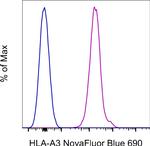Search Thermo Fisher Scientific
Invitrogen
HLA-A3 Monoclonal Antibody (GAP.A3), NovaFluor™ Blue 690, eBioscience™
FIGURE: 1 / 2
HLA-A3 Antibody (H071T03B09-A) in Flow


Product Details
H071T03B09-A
Species Reactivity
Host/Isotype
Class
Type
Clone
Conjugate
Excitation/Emission Max
Form
Concentration
Purification
Storage buffer
Contains
Storage conditions
RRID
Product Specific Information
Description: The monoclonal antibody GAP.A3 reacts with the human major histocompatibility complex (MHC) class I molecule HLA-A3, which is a member of the HLA-A family. HLA-A3 exists as two subtypes, HLA-A3.1 and HLA-A3.2, which differ at amino acid positions 152 and 156. MHC class I molecules are expressed on all nucleated cells. These molecules are highly polymorphic, cell surface glycoproteins that non-covalently associate with B2 microglobulin. MHC Class I molecules present intracellular peptides on the cell surface and nonnative peptides are recognized by circulating cytotoxic T lymphocytes. HLA-A3 is expressed by 15-25% of cancer patients and has been demonstrated to bind the tumor-associated antigen human telomerase reverse transcriptase (hTERT).
Each product contains 1 vial of NovaFluor conjugate and 1 vial of CellBlox Plus Blocking Buffer .
Applications Reported: This GAP.A3 antibody has been reported for use in flow cytometric analysis.
Applications Tested: This GAP.A3 antibody has been pre-titrated and tested by flow cytometric analysis of normal human peripheral blood cells. This can be used at 5 µL (0.6 µg) per test. A test is defined as the amount (µg) of antibody that will stain a cell sample in a final volume of 100 µL. Cell number should be determined empirically but can range from 10^5 to 10^8 cells/test.
NovaFluor dyes are not compatible with DNA intercalating viability dyes. Do not use viability dyes such as propidium iodide, 7-actinomycin D (7-AAD) and DAPI. Invitrogen LIVE/DEAD Fixable Dead Cell stains are recommended for use with NovaFluor dyes.
This NovaFluor conjugate has been updated to ship with CellBlox Plus Blocking Buffer (Cat. No. (C001T06F01)). This buffer contains formulation improvements over CellBlox. CellBlox Plus Blocking Buffer is required for optimal staining with NovaFluor conjugates and should be used in all experiments where NovaFluor conjugates are used. Whenever possible, we recommend adding CellBlox Plus Blocking Buffer to antibody cocktails/master mixes prior to combining with cells. Add 5 µL per sample (regardless of the number of NovaFluors in your panel) to use the antibody cocktail as intended. For single-color controls, use 5 µL of CellBlox Blocking Buffer per 100 µL of cell sample containing 10^3 to 10^8 cells.
NovaFluor conjugates are based on Phiton™ technology utilizing novel nucleic acid dye structures that allow for engineered fluorescent signatures with consideration for spillover and spread impacts. Learn more
Excitation: 494 nm; Emission: 585 nm; Laser: 488 nm (Blue) Laser
Target Information
HLA-A belongs to the HLA class I heavy chain paralogues. This class I molecule is a heterodimer consisting of a heavy chain and a light chain (beta-2 microglobulin). The heavy chain is anchored in the membrane. Class I molecules play a central role in the immune system by presenting peptides derived from the endoplasmic reticulum lumen. They are expressed in nearly all cells. The heavy chain is approximately 45 kDa and its gene contains 8 exons. Exon 1 encodes the leader peptide, exons 2 and 3 encode the alpha1 and alpha2 domains, which both bind the peptide, exon 4 encodes the alpha3 domain, exon 5 encodes the transmembrane region, and exons 6 and 7 encode the cytoplasmic tail. Polymorphisms within exon 2 and exon 3 are responsible for the peptide binding specificity of each class one molecule. Typing for these polymorphisms is routinely done for bone marrow and kidney transplantation. Hundreds of HLA-A alleles have been described.
HLA and MHC antibodies play a significant role in Immunopeptidomics, facilitating the identification and characterization of neoantigens through high-performance liquid chromatography coupled to tandem Mass Spectrometry.
For Research Use Only. Not for use in diagnostic procedures. Not for resale without express authorization.
How to use the Panel Builder
Watch the video to learn how to use the Invitrogen Flow Cytometry Panel Builder to build your next flow cytometry panel in 5 easy steps.
References (0)
Bioinformatics
Protein Aliases: A29 protein; antigen presenting molecule; HLA A; HLA class I antigen; HLA class I histocompatibility antigen, A alpha chain; HLA class I histocompatibility antigen, A-30 alpha chain; HLA class I histocompatibility antigen, A-33 alpha chain; HLA class I histocompatibility antigen, A-74 alpha chain; HLA locus; HLA-A; HLA-A locus alpha 2 domain; HLA-A null; HLA-Aw33.1; Human leukocyte antigen A; leukocyte antigen class I-A; MCH class I antigen; MHC class 1 antigen; MHC class I anti; MHC Class I antigen; MHC class I antigen A*30; MHC class I antigen A*33; MHC class I antigen A*74; MHC class I antigen heavy chain; MHC class I antigen HLA-A heavy chain; MHC class I antigen HLA-A33; MHC class I antigen null protein; MHC class I antigene; MHC class II antigen; MHC classI antigen; truncated MHC class I antigen
Gene Aliases: Aw-33; Aw-74; HLA-A; HLA-A11; HLA-A33; HLA-DQB1; HLA-DRB1; HLAA
UniProt ID: (Human) Q9TQM6
Entrez Gene ID: (Human) 3105

Performance Guarantee
If an Invitrogen™ antibody doesn't perform as described on our website or datasheet,we'll replace the product at no cost to you, or provide you with a credit for a future purchase.*
Learn more
We're here to help
Get expert recommendations for common problems or connect directly with an on staff expert for technical assistance related to applications, equipment and general product use.
Contact tech support

